August 1, 2013
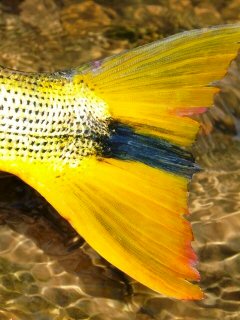 Yesterdays’ beating on the Itirizama River was far behind me when I awoke today. I was feeling extremely confident for fishing on the Lower Pluma River. Our guide was Carlos. To our advantage, Carlos was on this very water with Skip yesterday and knew where the golden dorado were.
Yesterdays’ beating on the Itirizama River was far behind me when I awoke today. I was feeling extremely confident for fishing on the Lower Pluma River. Our guide was Carlos. To our advantage, Carlos was on this very water with Skip yesterday and knew where the golden dorado were.
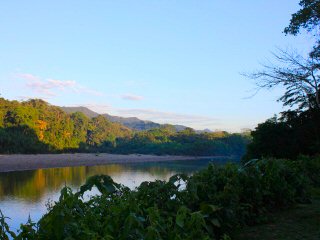 The Lower Pluma River is twice the size of Itirizama River. The beautiful river consists of cascading rapids followed by long slow moving bottomless pools. And the Pluma has a tinge of color to it making it far more forgiving when landing a cast near spooky dorado.
The Lower Pluma River is twice the size of Itirizama River. The beautiful river consists of cascading rapids followed by long slow moving bottomless pools. And the Pluma has a tinge of color to it making it far more forgiving when landing a cast near spooky dorado.
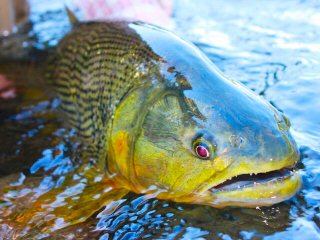 Each guide we’ve had here at the Tsimane Lodges has a slightly different strategy for dorado. I love it because I’m learning a variety of techniques. For example, Carlos is a big fan of pounding away at the shallow rapids, an area we really haven’t concentrated on much this week. Sure enough on the second run I connected on a voracious strike and landed this healthy 10lber. This fish came from a spot that I most likely would have passed up had I been on my own – I learned something.
Each guide we’ve had here at the Tsimane Lodges has a slightly different strategy for dorado. I love it because I’m learning a variety of techniques. For example, Carlos is a big fan of pounding away at the shallow rapids, an area we really haven’t concentrated on much this week. Sure enough on the second run I connected on a voracious strike and landed this healthy 10lber. This fish came from a spot that I most likely would have passed up had I been on my own – I learned something.
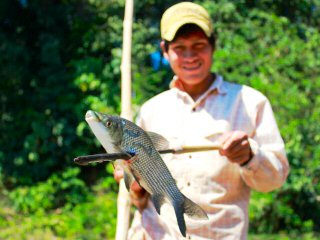 Last week while on the Secure River I showed a picture of a kid shooting arrows for sábalo (everything eats sábalo). Hunting sábalo is the thing to do if you live here. Anytime we’re near a village we see the locals hunting these plentiful fish. Till now I’d only seen one person actually kill a sábalo. That changed today. The locals controlling our boat for Carlos were absolute marksman. I watched the kid in the front of our dugout nail three sábalos in a row!
Last week while on the Secure River I showed a picture of a kid shooting arrows for sábalo (everything eats sábalo). Hunting sábalo is the thing to do if you live here. Anytime we’re near a village we see the locals hunting these plentiful fish. Till now I’d only seen one person actually kill a sábalo. That changed today. The locals controlling our boat for Carlos were absolute marksman. I watched the kid in the front of our dugout nail three sábalos in a row!
Despite the quick start, the dorado action never heated up. Tom caught one fish all day. I lucked into seven. Most were small dorado from 2-5lbs. The big boys simply weren’t showing themselves. That’s when I made a drastic fly change. The reason for my fly change is that the guides almost always recommend dark flies. Always black and something, but mostly black. I put on a worldwide big fish favorite of mine, a chartreuse Warpath Jig Fly, something these fish have never seen. The look on Carlos face was not the look of approval. I went with my gut anyway.
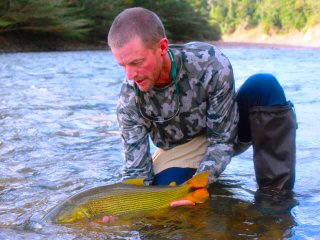 I fished the fly wildly. I didn’t just let it swing through the fast water while stripping; instead I jumped my rod tip up and down, sort of jigging it. I ended up sticking a couple more smallish dorado and then landed this second double digit dorado of the day.
I fished the fly wildly. I didn’t just let it swing through the fast water while stripping; instead I jumped my rod tip up and down, sort of jigging it. I ended up sticking a couple more smallish dorado and then landed this second double digit dorado of the day.
The highlight of the day was causing extreme carnage. I made a long cast across a deep pool with a black and red Warpath Fly. I made half a strip and hooked a small dorado. I’m not after small ones so like he was a 12” cutthroat on the Snake, I stripped him back rapidly. As he skipped across the surface a larger dorado smashed him from below. All I saw was a large flash of gold and the toothy jaws chewing on my fish. That’s when a MONSTER dorado leaped three feet out, turned in mid air and angled downward landing his jaws around my dorado. Normally this would result in a quick break off or at least loss of your fish. Not this time. I gave a few feet of slack and when I came tight I strip set like hooking a sailfish. The big boy was on!
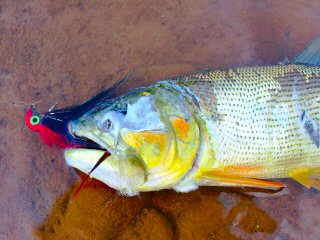 It’s rare, but evidently there was enough hook sticking out of the small dorado to sink into the big dorado. The beast leaped four times putting on a gill rattling dorado flinging freak show. It was an awesome sight. I thought for sure I had them both on one hook, but after the fourth of these wild jumps the 20lb plus (yes – over 20lbs!) dorado got loose. The little guy remained hooked and I dragged him in. Indeed sad, the eye hanging out, the body ripped apart, but its life in the Amazon.
It’s rare, but evidently there was enough hook sticking out of the small dorado to sink into the big dorado. The beast leaped four times putting on a gill rattling dorado flinging freak show. It was an awesome sight. I thought for sure I had them both on one hook, but after the fourth of these wild jumps the 20lb plus (yes – over 20lbs!) dorado got loose. The little guy remained hooked and I dragged him in. Indeed sad, the eye hanging out, the body ripped apart, but its life in the Amazon.
 Today was by no means what fly fishing in Bolivia is famous for but I lucked into some decent action. I won’t lie; I needed a day like today. Tomorrow is our last day and I’m still lacking two of my goals for this trip, land a big dorado or a pacu. One or the other and I’ll consider this trip a huge success.
Today was by no means what fly fishing in Bolivia is famous for but I lucked into some decent action. I won’t lie; I needed a day like today. Tomorrow is our last day and I’m still lacking two of my goals for this trip, land a big dorado or a pacu. One or the other and I’ll consider this trip a huge success.

I am amazed on how you can stay on top of your blog, even out where you are. You are making my breakfast more enjoyable. Have you tried any of Rob’s flies?
Glad warpath didn’t disappoint buddy and a good ace to have when the cards get low. I love tying for Bolivia and crazy places and great work buddy as your guy proved you t
Right!
If I think rivers near me, there is one that is rellay expensive. If at other rivers the price of fishing license is around 10 , in this river it is about 50 . At other rivers you can purchase yearly permit for 50 – 150 .